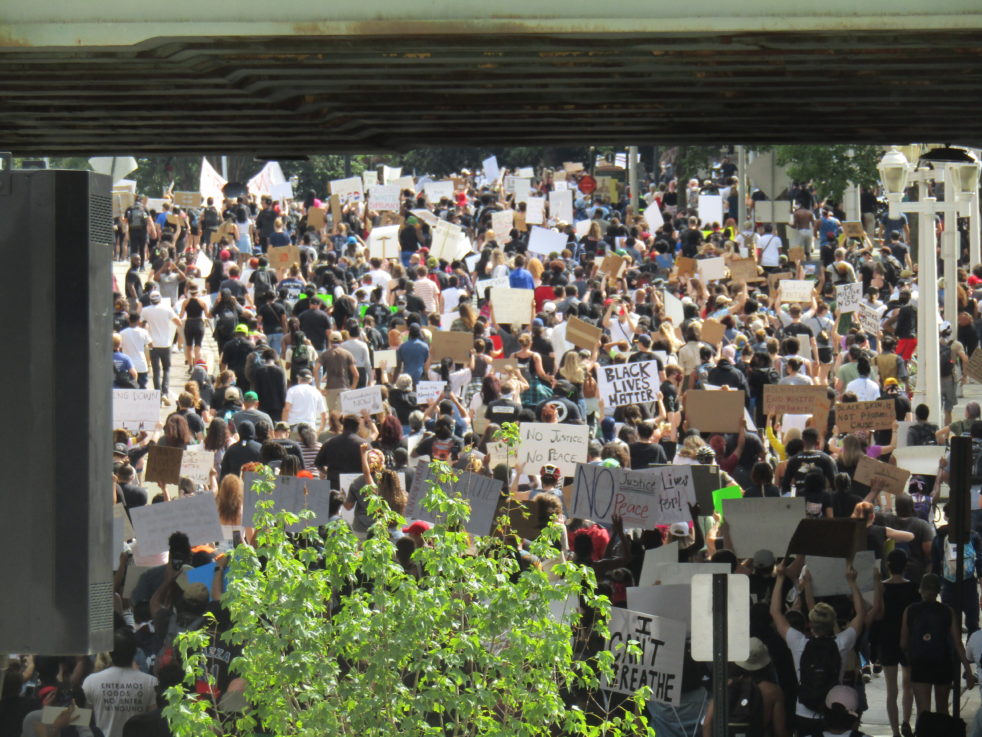On Friday, May 29, thousands of demonstrators filled the streets of downtown Atlanta in a protest against racial injustice in America, marching from Centennial Olympic Park to the Georgia State Capitol building over the course of the afternoon.
The protest was organized by community members just days before the event. Organizers met and collaborated through social media as they vented their frustrations with racial inequality on platforms like Twitter. From its inception, the protest was presented as a peaceful demonstration.
Earl D. Hamilton was one of five organizers of the protest; he and his colleagues began a social media campaign to raise awareness of the demonstration they were planning for this past Friday afternoon.
According to Hamilton, organizers also reached out to the city government, securing a permit for a demonstration and getting information on the regulations about protesting in the city. These rules were presented alongside a digital flyer that supporters used to spread word of the rally throughout various social media platforms.
The flyers provided scheduling information. They also emphasized the peaceful intent of the organizers: “REMINDER THIS IS A PEACEFUL PROTEST” was written in large bold font in the center of the image.
Organizers had low expectations for turnout on the afternoon of May 29. The march was scheduled to begin at 3:45 p.m., but protesters arrived as early as 3:00 p.m. at the Centennial Olympic Park amphitheater.
Organizers made sure that the protest had plenty of supplies for the afternoon. Piles of water bottles were stationed around the amphitheater, along with boxes of granola bars and other portable snacks. First aid kits, masks and hand sanitizer were among the medical supplies brought for protesters. Also available were pre-made signs and sign-making materials for protesters without their own signs. Organizers also brought milk as a precaution against tear gas and pepper spray.
When Hamilton and his colleagues saw that the crowd was growing, they decided to merge their event with another previously-scheduled event that was organized by the NAACP. Hamilton noted that “[protest organizers] were way over our head,” and that the “NAACP made it a lot better.” The addition of NAACP leaders brought the leadership of the protest to around 10 people, according to organizers.
At 3:45 p.m., the crowd began to march southwest down Centennial Olympic Park Drive., turning onto Martin Luther King Jr. Drive towards the capitol building. Hamilton described his reaction as the crowd, which had swollen to an enormous size, crossed the bridge: “When we were on the bridge … we saw how many people there were behind us … when we saw thousands of people behind us … it was jaw-dropping and breathtaking … there were tears in all of our eyes.”
Describing the atmosphere during the march, Hamilton noted, “lots of people that were sad and grieving … but the general atmosphere was very hopeful … people were coming together and showing a sense of community that I feel has been lost in recent times … people would cry, and absolute strangers came up and comforted them.”
Tolga Ustuner, third-year EE and Speaker of the SGA Undergraduate House of Representatives, was among the group of protesters. His assessment of the crowd’s atmosphere echoed Hamilton’s. “There was an air of both anger and joy: anger at the fact that we had to be there because this horrible injustice took place … people were frustrated … At the same time … there was some joy at the fact that this protest was taking place … it was a hopeful environment.“ When asked about his personal reason for participating in the demonstration, Ustuner replied, “It’s sad to see [systemic racism] persist … that’s what frustrates me … I wanted to stop being a neutral observant and actively take part … I decided to become an active ally.”
Protesters held signs aloft, marching to the chants: “No justice, no peace” and “I can’t breathe.” These chants echoed loudly as the group passed under overpasses in the Georgia State area of downtown.
Upon arrival at the Capitol building, three state representatives addressed the crowd. They emphasized the power of voting to the protesters gathered around the steps of the capitol. The organizers also gave members of the crowd “space to speak.” Several protesters shared stories of racial injustice, including one woman who shared the story of her 13-year-old brother who was killed by police.
After these addresses, the crowd turned around and made its way back to Centennial Olympic Park. The crowd was met with supportive honks from MARTA buses and other vehicles going the opposite way on Marietta Street.
Some protesters climbed up on the statue of Henry W. Grady and displayed signs as the crowd walked by. Chants of “F*** Donald Trump” and “F*** Brian Kemp” as well as “What do we want? Justice! When do we want it? Now!” rang out as the group made its way back to the park.
Upon arrival at the amphitheater, organizers and leaders addressed the crowd. Speakers included Hamilton as well as Gerald Griggs, a local lawyer, activist and member of NAACP. Griggs motivated the group to maintain their energy after the protest was over and to direct it to advocating for police reform legislation. He also asked demonstrators to put pressure on city council members and the mayor to bring real change to the city’s police force.
The protest concluded with a prayer offered up at the amphitheater at around 6:30 p.m.
